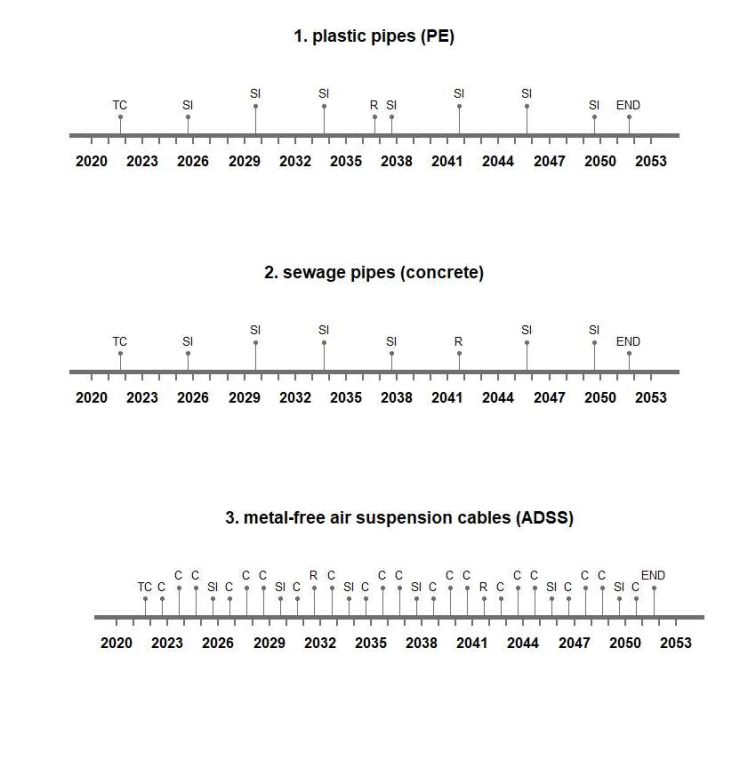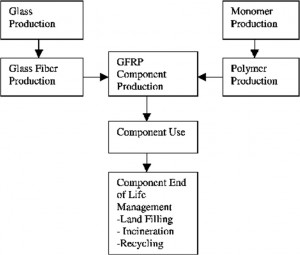1. Introduction
This assignment aims to conduct a life-cycle analysis of a tower of a wind turbine
as well as a multi-criteria decision-making analysis.
2. Civil engineering sub-system/ design options
As a sub-system, the type of installation or the pipes/protective tubes and the buried expansion are
considered and analysed in this work. The fibre optic cables are laid underground throughout
Germany. The fibre optic cables transmit the light pulses to the receiver and must be protected from
external influences by protective pipes.
In order to determine the required materials for the cable protection tubes, the following
parameters must be taken into account:
o Length of the buried fibre optic cable
o Length of the protective tubes
o Stiffness
o Material used
o Transport and installation options
To calculate the amount of material required, the length of the fibre optic cables to be laid and the
stiffness of the tubes are decisive.
There are not many options for protecting or laying the fibre optic cables. Plastic pipes are often used
as the material, which are then laid in a trench, see figure 2. Furthermore, fibre optic cables can be
integrated into sewage pipes, whose protective pipe is the surrounding concrete, see figure 1, and
fibre optic cables can also be routed along wooden poles, which consist of metal-free air suspension
cables (ADSS cable = All Dielectric Self Supporting), see figure 3
3. LCA
3.1 Goal and scope
GOAL:
This life-cycle assessment examines three design options of fibre optic cable laying and therefore
identifies their events and inventory throughout their life-cycles. In addition, specific aspects of the
impact of the installation variants are chosen and analyzed. The aim is to obtain information on the
environmental impact of the various design options with regard to different inputs. Furthermore, the
best installation option based on the defined inputs is to be crystallized based on this study. This
study will be conducted only for academic learning purposes and thus making them comparable. The
scope of this assignment will therefore be limited to the set of tasks which were required and targets
students and teacher. As the background research and conducted data was simplified, this paper
doesn’t claim completeness or intends public assertions.
SCOPE:
Product function: The task of the chosen installation method is the fast, direct and safe way of
storing the fibre optics. The selected installation method protects the fibre optic cable from external
damage and is intended to provide a fast connection of the fibre optic cable from the main centre to
the house or distributor.
Functional unit: The functional unit of a tower can be defined as the number of years in operation. In
this way, one can compare the different types of installation and compare the results with other
studies.
System boundary: A simple product tree of a fibre optic network is shown in figure 3.
Figure 3: product tree of fibre optic systems
3.2 Life- Cycle Time Span
It is unusual for glass fibre networks to change the type of installation or to replace the protective
pipes in which they are installed. Therefore, no maintenance work is foreseen for fibre optic
networks. Maintenance work only takes place for data transmission by Telekom, which tends to be
active at night, so that users do not notice it. This view excludes catastrophic events where cables
and protective pipes have to be patched. Therefore, in this work, rather smaller maintenance events
such as cleaning of the suspended cables, stability checks or replacement of patches/connectors are
considered. All these measures require only a very small amount of material, as the patches, for
example, are relatively small as a component. The most important inspected interventions that an
installer has to consider when maintaining the net are shown in Table 1. As can be seen, no cleaning
work is carried out for the buried protective cables and the waste water pipes. Here, it is hardly
possible to carry out annual maintenance because of the high costs involved when excavation work
has to be carried out. Furthermore, the cables inside the concrete sewage pipes are also difficult to
maintain, as the necessary expensive construction clearance has to be created here as well. We
therefore assume zero years for the cleaning work in options 1 and 2.

3.3 Life- Cycle Inventory
The installation variants examined here consist of three different materials: PE-HD, concrete and
metal-free PE. The following amounts were determined by research for the installation of 100 m of
fibre optic cable:
Option 1: empty conduit cable (PE-HD) 119 kg
Option 2: sewage pipes (integrated in concrete pipes) 252000 kg
Option 3: Suspended cables (“ADSS- all dielectric self- supporting”) 26 kg
This results in further figures for energy consumption, CO2 emissions and the glass fibres to be laid
for the production of the various cables. These are presented in the table, which shows the
quantities of materials used during the entire life cycle of the glass fibre network. Since the research
provided little information about the ADSS cables, assumptions were made here. The values for the
PE plastic cables were used for the ADSS cables. Furthermore, it should be noted here that it is
assumed that fewer pipes can be installed in the sewage concrete pipes and above ground (on the
wooden poles) due to the lack of space. The amounts are also shown in figure 5.
4. Multi- Criteria Decision Analysis
The multicriteria decision analysis was carried out using a TOPSIS analysis in Rstudio. The indicators
weight and glass fibre were weighted with 0.1, while energy and CO2 were weighted with 0.4. The
latter two indicators are considered “more important” for the environment. Although energy and
CO2 are to some extent interdependent, they were ranked higher because glass fibre is often
recycled and reused in the construction industry, for example. The recycled plastic is installed in
sewage pipes or wind turbines.
It is clear that in TOPSIS 1, design option 2 is ranked as the best option with 43.78%, which is due to the low values for energy and
CO2 consumption. Option 1 scores just below option 3 grade 28.07%. We also see that the values are very close, which is due to the
missing information for the ADSS cables. Once the positive and negative ideal solutions are included in the analysis, we see
that the options are ranked relatively equally. In the objective comparison, the TOPSIS 1 analysis makes more sense as option 1 has the worst scores in 3 out of 4 categories and should therefore not be considered equivalent to option 3. As a
conclusion, the positive and negative numbers for the ideal solution should be improved to get a
more accurate result of this analysis.
5. Discussion
Regarding the trade-offs made in this task, the most important is the limited choice of impact or
consumption categories. Only a small range was analysed, while other equally important figures
could not be proposed. Other impacts were not taken into account, for example the construction
work for laying or the execution work for creating the wooden masts. Here, further emissions are
emitted and transport also plays an important role in the costs of the laying work.
On the same hand, the choice of categories was very varied, so that different aspects could influence
the results. Resuming to this, further approaches could concentrate more on a specific field, for
example only the gas emissions during the life cycle.
In addition, the influence of the plastic cables on the CO2 balance is higher than that of the concrete,
which leads to a worse CO2 balance at the time of construction. However, it must be taken into
account that laying plastic pipes can last up to 30 years, so the carbon footprints can balance out
after the lifetime of the cables. To obtain more accurate results, different life spans should be
considered.
6. Sources
https://docplayer.org/6202540-Alho-architektur-die-vielfalt-des-modularen-raums.html
https://www.researchgate.net/figure/Life-cycle-environmental-impacts-from-production-of-glassfiber-
china-reed-fiber-Epoxy_tbl2_222403148
https://community.fs.com/de/blog/tips-for-using-and-maintaining-fiber-patch-cables.html
https://www.schoengen.de/fileadmin/website/download/prospekte/pdf/2_1_Schutzrohre_PEHD_
Stangenware_2016_A4_oP.pdf
https://www.rinninger.de/index.php/rohre-titel/betonrohre-kreisrund
https://www.rehau.com/downloads/510054/katalog-rehau-telekommunikation.pdf
https://www.fbsrohre.de/fileadmin/content/shop/nachhaltigkeit/fbs-expertise-oekologie.pdf
https://www.oeko.de/fileadmin/oekodoc/Digitaler-CO2-Fussabdruck.pdf
https://www.deutschlandfunk.de/recycling-von-glasfaser-kunststoff-aus-windkraftraedern-100.html


